NavSource Online: Submarine Photo Archive
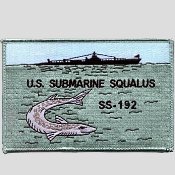
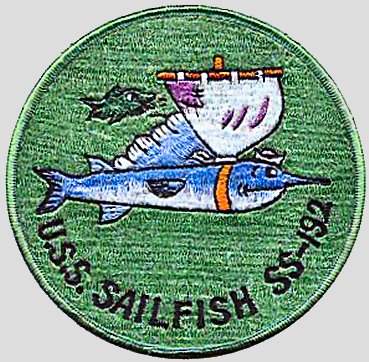
Patches courtesy of Don McGrogan BMCS, USN (ret.)
Squalus / Sailfish (SS-192)

![]()
![]()
![]()
![]()
Unit Awards, Campaign and Service Medals and Ribbons
Presidential Unit Citation
| Click On Image For Full Size | Size | Image Description | Source | |
|---|---|---|---|---|
 |
52k | Squalus acanthias, one of the spiny sharks (dogfish sharks) scientifically known as Squalidal. | Courtesy of photolib.noaa.gov via wikipedia.org. | |
 |
22k | Commemorative postal cover on the occasion of the keel laying of the Squalus (SS-192), 18 October 1937, at Portsmouth Navy Yard, Portsmouth, N.H. | Courtesy of Jack Treutle (of blessed memory). | |
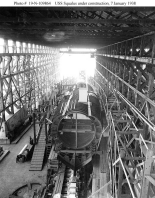 |
147k | Squalus (SS-192), under construction on the building ways at the Portsmouth Navy Yard, Kittery, Maine, 7 January 1938. View looks aft, showing typical cross section of pressure hull and side tanks. Frame 41 lower structure is in the foreground, with Frame 46 upper hull structure beyond. | US National Archives photo # 19-N-109864, from the Bureau of Ships Collection now in the collections of the US Naval Archives. | |
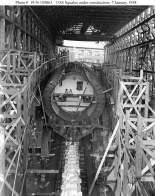 |
152k | Squalus (SS-192), under construction on the building ways at the Portsmouth Navy Yard, Kittery, Maine, 7 January 1938. View looks forward, showing typical cross section of pressure hull and side tanks. Frame 155 lower structure is in the foreground, with Frame 145 upper hull structure beyond and Bulkhead 134 visible within the hull. | US National Archives photo # 19-N-109863, from the Bureau of Ships Collection now in the collections of the US Naval Archives. | |
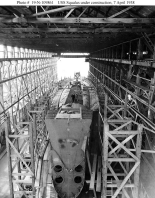 |
144k | Squalus (SS-192), under construction on the building ways at the Portsmouth Navy Yard, Kittery, Maine, 7 April 1938. View looks aft, with forward torpedo tube supporting structure in the foreground. | US National Archives photo # 19-N-109861, from the Bureau of Ships Collection now in the collections of the US Naval Archives. | |
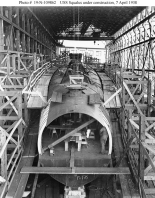 |
154k | Squalus (SS-192), under construction on the building ways at the Portsmouth Navy Yard, Kittery, Maine, 7 April 1938. View looks aft, with forward torpedo tube supporting structure in the foreground. | US National Archives photo # 19-N-109862, from the Bureau of Ships Collection now in the collections of the US Naval Archives. | |
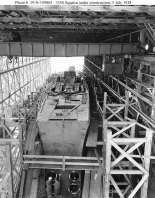 |
139k | Squalus (SS-192), under construction on the building ways at the Portsmouth Navy Yard, Kittery, Maine, 5 July 1938. View looks aft with forward torpedo tube supporting structure in the lower foreground. | US National Archives photo # 19-N-109865, from the Bureau of Ships Collection now in the collections of the US Naval Archives. | |
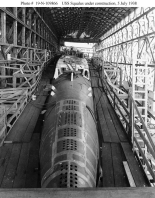 |
136k | Squalus (SS-192), under construction on the building ways at the Portsmouth Navy Yard, Kittery, Maine, 5 July 1938. View looks forward from over the stern. | US National Archives photo # 19-N-109866, from the Bureau of Ships Collection now in the collections of the US Naval Archives. | |
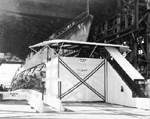 |
274k | Launching ramp & platform for the Squalus (SS-192), 14 September 1938. | USN photo courtesy of Scott Koen & ussnewyork.com. | |
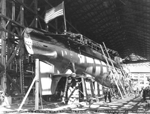 |
432k | General view of the Squalus (SS-192) looking forward, prior to launching on the building ways at the Portsmouth Navy Yard, Kittery, Maine, on 14 September 1938. | USN photo # 448-39, courtesy of Scott Koen & ussnewyork.com. | |
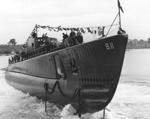 |
273k | The launching of the Squalus (SS-192), at 3;15 PM on 14 September 1938. | Photo courtesy of onr.navy.mil (Office of Naval Research) & submitted by Bill Gonyo. | |
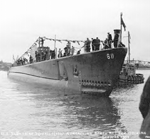 |
216k | Have tug, will travel: Squalus (SS-192) gets ready for a push following launching on 14 September 1938. | USN photo courtesy of Scott Koen & ussnewyork.com. | |
 |
273k | Before berth photo: Tugs maneuvering the Squalus (SS-192) for docking at berth # 1 after launch on 14 September 1938. | USN photo # 326-39, courtesy of Scott Koen & ussnewyork.com. | |
 |
257k | Before berth photo: Tugs maneuvering the Squalus (SS-192) for docking at berth # 1 after launch on 14 September 1938. | USN photo # 326-39, courtesy of Scott Koen & ussnewyork.com. | |
 |
15k | Commemorative postal cover on the occasion of the launching of the Squalus (SS-192), 14 September 1938. | Courtesy of Jack Treutle (of blessed memory). | |
 |
43k | Commemorative postal cover on the occasion of the launching of the Squalus (SS-192), 14 September 1938. | Courtesy of Jack Treutle (of blessed memory). | |
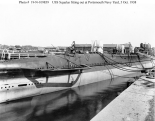 |
78k | Squalus (SS-192), fitting out, at the Portsmouth Navy Yard, Kittery, Maine, 5 October 1938. This view looks forward from off the starboard quarter, with propeller guard and stern torpedo tube doors at left. YO-13 is in the left background. | US National Archives photo # 19-N-109859, from the Bureau of Ships Collection now in the collections of the US Naval Archives. | |
 |
190k | Squalus (SS-192), fitting out, at Portsmouth Navy Yard, Portsmouth, N.H., 5 October 1938. | US National Archives photo # 19-N-109858, from the Bureau of Ships Collection now in the collections of the US Naval Archives. | |
 |
216k | Squalus (SS-192), fitting out, at Portsmouth Navy Yard, Portsmouth, N.H., 7 January 1939. | US National Archives photo # 19-N-109860, from the Bureau of Ships Collection now in the collections of the US Naval Archives. | |
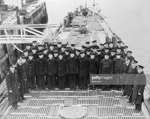 |
454k | (Original Caption) Part of the heroic crew of the Squalus (SS-192), later trapped within the disabled craft 240 feet beneath the surface of the sea, are pictured when the underseas boat was commissioned 1 March 1939. The Squalus was making a routine dive on the morning of 4 August 1939, when a defective air induction valve flooded the after part of the sub, quickly sinking her. All or a large portion of the crew were believed alive and were being sought to bring to the surface on 5 August 1939. | Photo by Getty Images, courtesy of gettyimages.com. | |
 |
15k | Commemorative postal cover on the occasion of the commissioning of the Squalus (SS-192), 1 March 1939. | Courtesy of Jack Treutle (of blessed memory). | |
| Loss & Salvage |
||||
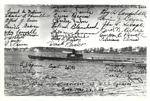 |
973k | Photo entitled "Survivors of Squalus (SS-192) Sunk May 23, 1939." Note that she does not have limber holes at all. The date of the photo would have to be between 1 March 1939 (original commissioning) and 23 May 1939 (date of sinking) and most likely was taken in the Piscataqua River while she was headed out or returning from her initial sea trials. An unsigned photo is seen here. |
USN photo courtesy of Scott Koen & ussnewyork.com & Wendy S. Gulley, Archivist, Submarine Force Museum,Naval Submarine Base, NLON, Groton, CT. Photo i.d. courtesy of David Johnston |
|
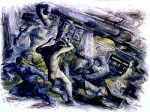 |
125k | The Squalus (SS-192) hits the bottom of the ocean stern first off the coast of Portsmouth New Hampshire to rest in 240 feet of water. Thirty-three of the 59 crew members survived in the forward chambers of the submarine. This picture depicts the control room of the submarine and crew members desperately closing off water leaks. | US Naval Historical Center / "Moment of Impact" John Groth #1, Watercolor & ink, 1966 88-161-QS. |
|
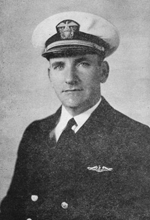 |
774k | Squalus (SS-192) Commanding Officer, Lieutenant Oliver F. Naquin. Squalus's Christmas tree was green when she dived. |
Photo courtesy of Lane Memorial Library (library@hampton.lib.nh.us)via Bill Gonyo. PDF courtesy of Scott Koen & ussnewyork.com. |
|
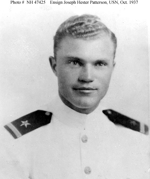 |
49k | Ensign Joseph Hester Patterson, USN. Photograph taken 13 October 1937, while he was serving in Louisville (CA-28). Ensign Patterson was lost in the accidental sinking of Squalus (SS-192) on 23 May 1939. |
USNHC photograph # NH 47425 courtesy of Bill Gonyo. | |
 |
101k | Squalus (SS-192) crewmembers huddle around a lamp in the forward torpedo room awaiting rescue in cold conditions which resulted in some survivors suffering from exposure. However, no permanent adverse health effects were noted in survivors after the rescue. | US Naval Historical Center / "Sweating It Out" (Torpedo Room) John Groth #2, Watercolor & ink, 1966 88-161-QT. |
|
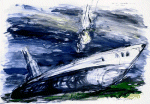 |
85k | The rescue divers were indispensable in the rescue and subsequent salvage operation of the Squalus (SS-192), making a total of 648 deep-water tethered dives. They dived first to the wreck, where they anchored guide wires for the rescue bell to the escape hatch on the submarine. When the rescue bell became fouled on the 4th rescue trip, they attempted to unfoul the lines and get it to the surface. Each dive entailed considerable risk for the divers due to risk from the bends and "narcosis of the deep," a hallucinatory condition. | US Naval Historical Center / USS Squalus and Diver John Groth #4, Watercolor & ink, 1966 88-161-QV. |
|
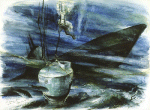 |
80k | On the 4th rescue dive of the McCann diving bell, the steel wire used to raise the bell to the surface became fouled. The bell was lowered to the ocean floor and divers sent down in an unsuccessful attempt to unfoul the wire. The bell was subsequently raised through the manipulation of buoyancy in the ballast tanks, and manual hauling to the surface. | US Naval Historical Center / USS Squalus and Diving Bell John Groth #7, Watercolor & ink, 1966 88-161-QY. |
|
 |
2.30k | Thirty six page PDF of the Squalus (SS-192) history & sinking on 23 May 1939. | USN photo courtesy of Scott Koen & ussnewyork.com. | |
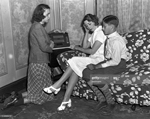 0819262i | 2.11k | Family Waiting by Radio for News About the Squalus (SS-192) Martha Beyer and her children sit near a radio as they wait for information about the Squalus, which sank due to a valve failure during a practice dive on 23 May 1939 killing 26 people. Her brother Theodore Jacobs was a crewman and one of the survivors on the submarine. |
Photo by Bettmann Archive via Getty Images courtesy of gettyimages.com. | |
 0819207s |
NR | 27 Men Trapped On Floor Of Ocean Are Put Down As Dead First Time in History of Submarines Any Rescue of Kind Has Been Made; Diving Bell Hastily Sent Down for More Survivors. Portsmouth, N. H., May 24: Seven men entombed for more than 29 hours in the crippled submarine Squalus (SS-192) were pulled to safety today in a rescue chamber raised through 240 feet of water, and immediate preparations were made for another descent to save as many as possible of the other 52 men still trapped below. The first survivors reported 25 of their colleagues, including three officers, were still alive inside the submarine, and that still others might have held on to life without their knowledge. Women Wait Sadly Near Navy Yard Wives, Sweethearts and Children of Men Trapped on Submarine Present Pitiable Sights Ashore |
Image and text provided by University of North Carolina at Chapel Hill Library, Chapel Hill, NC. Photo from the Henderson Daily Dispatch. (Henderson, N.C.) 1914-1995, 24 May 1939, Image 1, via chroniclingamerica.loc.gov. | |
 0819229 |
NR | Portsmouth-Bound Wife Learns News as Train Stops Here Mrs. Robert Franklin Gibbs, Rumanian-born wife of one of the seamen trapped on the submarine Squalus (SS-192), shown at Union Station aboard a train for Portsmouth, N. H. Her husband's uncle, F. O. Barrett, is helping her read the newspaper headlines about the ill-fated ship, her first word about the disaster. |
A.P. Photo. Image and text provided by Library of Congress, Washington, DC. Photo from the Evening Star. [volume] (Washington, D.C.) 1854-1972, 24 May 1939, Image 2, via chroniclingamerica.loc.gov. | |
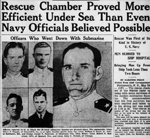 0819274 |
NR | Rescue Chamber Proved More Efficient Under Sea Than Even Navy Officials Believed Possible Officers Who Went Down With Submarine |
Image and text provided by Connecticut State Library, Hartford, CT. Photo from the The Waterbury Democrat. [volume] (Waterbury, Conn.) 1917-1946, 24 May 1939, Image 1, via chroniclingamerica.loc.gov. | |
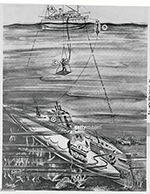 |
316k | (Original Caption) New York: Rescue Sketch. Artist's Conception Of Submarine Rescue. Here is how an Artist sees the attempt to rescue the 59 men trapped aboard the U.S. submarine Squalus (SS-192) on the bottom of the sea 12 miles off Portsmouth, N.H. (A), the Falcon (ASR-2) submarine tender anchored above the sunken craft (B), the telephone buoy with which the Squalus established contact with a sister ship. However the communication line was severed before much information could be given. (C) a diver is shown descending on a platform in an attempt to close the faulty induction valve that caused the accident. If all other means fail crew members will leave their stricken craft and come to the surface, aided by the Momsen lung. A respirator like device that enables them to breathe during the 240 foot ascent. |
Photo Bettmann Collection/Getty Images, courtesy of gettyimages.com. | |
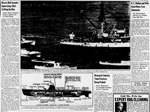 0819214 | NR | PORTSMOUTH, N. H.—PREPARING FOR RESCUE — The crew of the submarine rescue ship Falcon (ASR-2) is shown in this closeup air view, taken off here today, as they prepared big diving bell in which men were removed from the sunken submarine Squalus (SS-192). Meanwhile, divers were below, preparing for the bell to be attached to the stricken undersea craft. This diagram gives an idea of the Interior of the Squalus. The $4,000,000 vessel was pinned to the bottom when an air induction valve—either the pipe indicated or another, smaller, one—failed to close. The after compartments were reported flooded. |
A. P. Wirephoto From Chicago Tribune. Image and text provided by Library of Congress, Washington, DC. Photo from the Evening star. [volume] (Washington, D.C.) 1854-1972, 24 May 1939, Image 5,via chroniclingamerica.loc.gov. | |
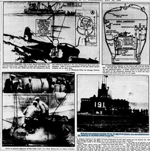 0819224 |
137k | RESCUE PLAN CHARTED—This is how rescue ship Falcon (ASR-2) lowered the Navy's new "diving bell" to save men entrapped in the Squalus (SS-192). Use of the bell, which fits over the submarine's hatch, was ordered by Admiral C. W. Cole, Portsmouth Navy Yard commandant. Inset A Is an enlargement of the bell, which accommodates six or eight men. A cross-section diagram of the Navy's new nine-ton diving bell. Ten feet high, the bell has two compartments and carries its own operating engine. A rubber jacket at its base fits over the hatch of the submarine, allowing men to enter the lower chamber and climb from there to the upper. With the crew anxiously scanning the sea for sign of the Squalus crew, the submarine Sculpln (SS-191) stands by at the scene—unable to give aid. |
A. P. Wirephoto. Image and text provided by Library of Congress, Washington, DC. Photo from the Evening Star. [volume] (Washington, D.C.) 1854-1972, 24 May 1939, Image 4, via chroniclingamerica.loc.gov. | |
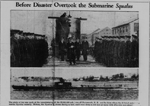 0819239$ |
NR | Before Disaster Overtook the Submarine Squalus (SS-192) The photo at top was made at the commissioning of the $5,000,000 submarine Squalus recently. Bottom, the Squalus is shown during a test run off Portsmouth, N. H., not far from where the ill-fated undersea craft went down in 240 feet of water with fifty-nine men aboard. |
Image and text provided by University of North Carolina at Chapel Hill Library, Chapel Hill, NC. Photo from the Henderson Daily Dispatch. (Henderson, N.C.) 1914-1995, 25 May 1939, Image 1, via chroniclingamerica.loc.gov. | |
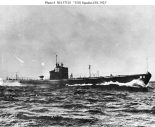 |
112k | 1939 vintage photograph, which was widely used to represent Squalus (SS-192) at the time of her sinking in May of that year. This is actually a photo of Salmon (SS-182), retouched to change Salmon's side number (SS-1) to that of Squalus (SS-11). See Photo # NH 63417 for the original, unretouched image. | Photograph # NH 57510 from the Bureau of Ships Collection in the U.S. National Archives, courtesy of the US Naval Historical Center. | |
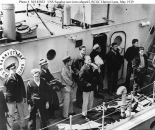 |
118k | Squalus's (SS-192) Commanding Officer, Lieutenant Oliver F. Naquin (center, hatless, wearing khaki pants), with other survivors on board the Coast Guard Cutter Harriet Lane (WSC-141), bound for the Portsmouth Navy Yard, Kittery, Maine, following their rescue, 25 May 1939. | Photograph # NH 85832 from the Bureau of Ships Collection in the U.S. National Archives, from the collections of the US Naval Historical Center. | |
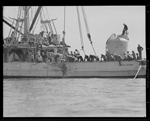 |
761k | Rescue chamber on the salvage tug Falcon (ASR-2) to be used to rescue crew from sunken Squalus (SS-192). A diver descends from the Falcon . | Photo # 08_06_023268 courtesy of the Boston Public Library, Leslie Jones Collection via Sean Hert & flickr.com. | |
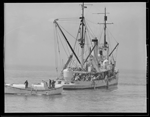 |
846k | Stern view of the Falcon (ASR-2) with the McCann Rescue chamber Squalus (SS-192). | Photo # 08_06_023271 courtesy of the Boston Public Library, Leslie Jones Collection via Sean Hert & flickr.com. | |
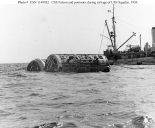 |
94k | Squalus (SS-192) salvage pontoons near Falcon (ASR-2), during salvage operations on the sunken submarine,off the New Hampshire coast in the Summer of 1939. | Photograph # USN 1149032 from the Bureau of Ships Collection in the U.S. National Archives, courtesy of the US Naval Historical Center. | |
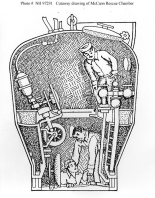 |
159k | McCann Rescue Chamber cutaway drawing of the device used to rescue 33 crewmen from the sunken submarine Squalus' (SS-192) in May 1939. | Official USN photo # NH 97291, courtesy of the US Naval Historical Center. | |
 0819270 |
NR | PORTSMOUTH, N. H. FIRST CREWMAN UP ALIVE Roland Blanchard of Hersey, Mich., emerges from the Squalus (SS-192), first of the crew to be raised alive. Note tense expressions and attitudes of men along the rail. Rescue worker is leaning over to pull second man out. After Blanchard was safely on deck the men broke into cheers. Engine Room Crew Sacrificed Lives, Experts Believe Chose to Try to Help Men Fighting to Close Valves, Is View Here. |
Image and text provided by Library of Congress, Washington, DC. Photo from the Evening Star. [volume] (Washington, D.C.) 1854-1972, 25 May 1939, Image 3, via chroniclingamerica.loc.gov. | |
 0819207a |
NR | Hope Never Left Crew of Squalus (SS-192), Lt. Nichols Relates, No Panic Among Men, No Dramatic Speeches, Says Rescued Officer PORTSMOUTH, N. H.—LAST MAN ASHORE—True to the sea’s tradition, Lt. Oliver E. Naquin (right) is the last to leave the cutter bringing the final group of rescued men from the sunken Squalus today. He is greeting two brother officers. Survivors leaving the cutter Harriet Lane (WSC-141). Judson Bland, one of the first men to be saved, is shown being greeted by his overjoyed wife Nadine. LOS ANGELES PRAYS IN VAIN Roberta Coffey, 3, prays before picture of her father, Robert L. Coffey, seaman entombed on the Squalus. The Navy reported her father was one of those "probably dead." |
Image and text provided by Library of Congress, Washington, DC. Photo from the Evening Star. [volume] (Washington, D.C.) 1854-1972, 25 May 1939, Image 1, via chroniclingamerica.loc.gov. | |
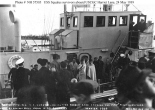 |
87k | U.S. Coast Guard Cutter Harriet Lane (WSC-141) landing the first nine Squalus (SS-192) survivors at the Portsmouth Navy Yard, Kittery, Maine, on 24 May 1939. Some of the surviors are visible in center, wrapped in blankets. They had been recovered from the sunken submarine by a McCann Rescue Chamber deployed from Falcon (ASR-2). Squalus had sunk in the Atlantic, off Portsmouth, on the previous day. | Official USN photo # NH 57505, courtesy of the US Naval Historical Center. | |
 0819272 |
NR | PORTSMOUTH, N. H.—DIVER'S LIFELINE —Only one man goes down to the ocean's bottom in a diving suit, but it takes a whole crew on deck to care for his air hose and safety line, as shown when this diver descended to the side of the sunken Squalus (SS-192). Note man guiding descending platform on which diver stands, while others (at left) tend airhose and safety rope. At center, another holds weighted rope which guides the diver. Three of the five men who scrambled from the flooded aft compartment of the Squalus just before the water-tight door was closed, talking it over with fellow crew members in Navy Hospital. Left to right: Raymond F. O'Hara, Roland Blanchard, Charles Yuhas, William Isaacs and Lawrence Galnor. O'Hara, Blanchard and Isaacs were the three who made it-from death to safety. |
A.P. Wirephoto Image and text provided by Library of Congress, Washington, DC. Photo from the Evening Star. [volume] (Washington, D.C.) 1854-1972, 26 May 1939, Image 4, via chroniclingamerica.loc.gov. | |
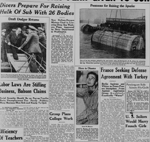 0819273 |
NR | Hero in Disaster Lloyd B. Maness of Greensboro, N. C., an electrician’s mate, was hailed as the hero of the Squalus (SS-192) disaster, credited with being the man who jammed shut the door which cut off the flooded sections of the submarine from the compartments in which the survivors lived for more than 30 hours. |
(Central Press) Image and text provided by University of North Carolina at Chapel Hill Library, Chapel Hill, NC. Photo from the Henderson Daily Dispatch. (Henderson, N.C.) 1914-1995, 27 May 1939, Image 1, via chroniclingamerica.loc.gov. | |
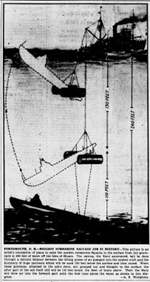 0819227 |
NR | BIGGEST SUBMARINE SALVAGE JOB IN HISTORY: This picture is an artist's conception of plans to raise the sunken submarine Squalus (SS-192) to the surface from her graveyard in 240 feet of water off the Isles of Shoals. The raising, the Navy announced, will be done through a delicate balance between the lifting power of air pumped into the sunken craft and the buoyancy of huge pontoons which will be sunk 130 feet below the surface and then raised. When these pontoons, attached to the sub's stern, are pumped out and brought to the surface, the after part of the sub itself still will be 110 feet below the fleet of boats above. Then the Navy will blow air into the forward part until the bow rises above the water as shown in this diagram. | A. P. Wirephoto. Image and text provided by Library of Congress, Washington, DC. Photo from the Evening Star. [volume] (Washington, D.C.) 1854-1972, 28 May 1939, Image 4, via chroniclingamerica.loc.gov. | |
 |
68k | Scene on the after deck of Falcon (ASR-2) during the early stages of the salvage operations, 30 May 1939, showing congested conditions. View looks to port, with men assisting a diver toward the left. Officer behind them, in center, appears to be Commander Allan R. McCann. Photographed by the Portsmouth Navy Yard, Kittery, Maine. | Official USN photo # NH 57501, courtesy of the US Naval Historical Center & submitted by Bill Gonyo. | |
 0819223 | NR | Squalus (SS-192) Rescue Writes Undersea History (Left) Up from the 240-foot depth of the sunken submarine Squalus, members of the crew are helped from the diving bell that has mitigated the terror of being trapped on the sea bottom. It saved the lives of all 33 men not drowned in the flooded chambers. They can smile now. Coming through the ordeal with praise from their superiors, Lt. O. F. Naquin, center), commander, and Lt. Robert Robertson, officer of the Squalus, relax as they chat with Lt. Comdr. Longstaff at the Portsmouth Navy Yard. Lloyd B. Maness, who slammed the water-tight door that doomed the lost men but saved the living, is shown in hospital at Portsmouth. Men of the hour in Squalus tragedy. A truck load of divers from the Washington Navy Yard diving school arriving at Portsmouth Navy Yard to board ship for scene of operations to raise the Squalus. (Right) Huge steel pontoons are loaded on barges at the Portsmouth yard for use in raising the Squalus. A group of rescued aboard salvage ship Falcon (ASR-2), before being removed to shore from scene of the submarine tragedy off the New Hampshire coast. |
A.P. and Wide World Photos. Image and text provided by Library of Congress, Washington, DC. Photo from the Evening Star. [volume] (Washington, D.C.) 1854-1972, 04 June 1939, Image 100, via chroniclingamerica.loc.gov. | |
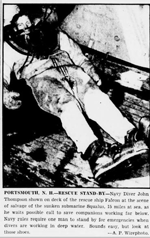 0819269 | NR | RESCUE STAND-BY Navy Diver John Thompson shown on deck of the rescue ship Falcon (ASR-2) at the scene of salvage of the sunken submarine Squalus (SS-192), 15 miles at sea as he waits possible call to save companions working far below. Navy rules require one man to stand by for emergencies when divers are working in deep water. Sounds easy, but look at those shoes! |
A.P. Wirephoto. Image and text provided by Library of Congress, Washington, DC. Photo from the Evening Star. [volume] (Washington, D.C.) 1854-1972, 11 June 1939, Image 30, via chroniclingamerica.loc.gov. | |
 |
137k | Percolating water rises from the salvage pontoons during salvage operations on the sunken submarine, off the New Hampshire coast in the Summer of 1939. | USN photo courtesy of Scott Koen & ussnewyork.com. | |
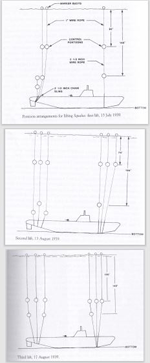 0819233 | 758k | Squalus (SS-192) raising: 3 photo PDF showing pontoon arrangement for lifting the sub. | Images and text from Mud, Muscles, and Miracles: Marine Salvage in the United States Navy. 2nd Edition. By Captain Charles A. Bartholomew, USN, and Commander William I. Milwee, Jr., USN, (Ret.). Naval History & Heritage Command, Naval Sea Systems Command, Department of the Navy, Washington D.C., 2009, via Robert Hurst. | |
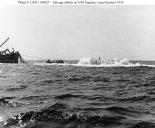 |
129k | A salvage pontoon surfaces during an attempt to lift Squalus (SS-192) from the sea bottom off the New Hampshire coast, in the Summer of 1939. The bow of Falcon (ASR-2) is at the extreme left. This appears to be the 13 July 1939 lift, in which Squalus' bow rose uncontrollably to the surface and then sank. If that is the case, the pontoon visible here is probably the upper pontoon of the lifting lines attached to the sunken submarine's bow. | Official USN photo # USN 1149027, courtesy of the US Naval Historical Center. | |
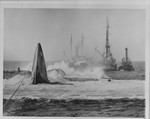 |
795k | Squalus' (SS-192) bow comes to the surface as personnel based on Falcon (ASR-2) struggle to refloat the sunken submarine, off the New Hampshire coast during the Summer of 1939. This appears to be the 13 July 1939 lift, in which Squalus' bow rose uncontrollably to the surface and then sank. If that is the case, the salvage pontoons nearby would include both bow line pontoons, plus the two upper pontoons on the stern lifting line. The ship's hull number 192 is painted on her bow. The abortive surfacing wrecked 13,600 feet of air hoses running from the salvage ship to the pontoons to the ballast tanks of the submarine. |
Partial text from War Under The Pacific, by K. Wheeler, and submitted courtesy of Robert Hurst. Photo # 08_06_023262 courtesy of the Boston Public Library, Leslie Jones Collection via Sean Hert & flickr.com. | |
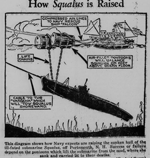 0819239h |
NR | How Squalus (SS-192) is Raised This diagram shows how Navy experts are raising the sunken hull of the ill-fated submarine Squalus off Portsmouth, N. H. Success or failure depend on the pontoons which lift the submarine from the mud, where she sank and carried 26 to their deaths. |
Image and text provided by University of North Carolina at Chapel Hill Library, Chapel Hill, NC. Photo from the Henderson Daily Dispatch. (Henderson, N.C.) 1914-1995, 15 July 1939, Image 6, via chroniclingamerica.loc.gov. | |
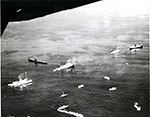 |
829k | Aerial View of the Rescue Operation of the Squalus (SS-192). The Sculpin (SS-191) is off the port side of the Falcon (ASR-2) in center. |
National Archives Identifier: 6281167 Photo courtesy of catalog.archives.gov | |
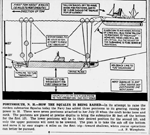 0819263a | NR | HOW THE SQUALUS (SS-192) IS BEING RAISED: In its attempt to raise the sunken submarine Squalus today the Navy has added three pontoons to its gearing, raising the power to 10. There were seven pontoons attached to her July 13 when the craft broke loose and one sank. The pontoons are placed at precise depths to bring the submarine 80 feet off the bottom for the first lift. The lower pontoons will be in their desired position for the second lift, and only the upper pontoons will need to be lowered. The plan is to take the sub off the bottom and move it by easy stages—4 miles on the first trip—toward shallows, where rescue operations can better be pursued. | A. P. Wirephoto. Image and text provided by Library of Congress, Washington, DC. Photo from the Evening Star. [volume] (Washington, D.C.) 1854-1972, 12 August 1939, Image 5, via chroniclingamerica.loc.gov. | |
 |
451k | Drawing of the rescue operations on the Squalus (SS-192) that sank off the coast of New Hampshire. | Photo by ullstein bild via Getty Images, courtesy of gettyimages.com. | |
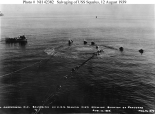 |
90k | Blowing of salvage pontoons to lift Squalus' (SS-192) off the sea bottom, 12 August 1939. Photographed by the Portsmouth Navy Yard, Kittery, Maine. Original photo is mis-identified as showing salvage of Sculpin (SS-191), which was present to support the operations, but was not the object of them. | Official USN photo # NH 42382, courtesy of the US Naval Historical Center. | |
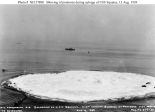 |
68k | Air comes to the surface during blowing of salvage pontoons to lift Squalus (SS-192) off the sea bottom, 12 August 1939. There were separate groups of pontoons supporting the sunken submarine's bow and stern. Three pontoons were located at the top of the lift line in each location and surfaced during the 12 August lift. One more pontoon remained underwater on the bow line and three more on the stern line when this lift was completed. Photographed by the Portsmouth Navy Yard, Kittery, Maine. | Official USN photo # NH 57898, courtesy of the US Naval Historical Center. | |
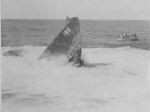 |
603k | Raising the sub Squalus (SS-192) after accident. | Photo # 08_06_023265 courtesy of the Boston Public Library, Leslie Jones Collection via Sean Hert & flickr.com. | |
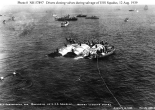 |
126k | Divers closing valves in salvage pontoons after Squalus (SS-192) had been lifted off the sea bottom, 12 August 1939. There were separate groups of pontoons supporting the sunken submarine's bow and stern. Three pontoons were located at the top of the lift line in each location, and came to the surface during the 12 August lift. One of these groups is seen here. After this lift, one more pontoon remained underwater on the bow line and three more on the stern line. Photographed by the Portsmouth Navy Yard, Kittery, Maine. | Official USN photo # NH 57897, courtesy of the US Naval Historical Center. | |
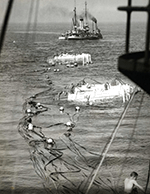 |
741k | Raising of the Pontoons Attached to the stern of the Squalus (SS-192). | National Archives Identifier: 6281169 Photo courtesy of catalog.archives.gov | |
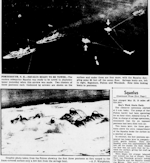 |
NR | PORTSMOUTH, N. H., SQUALUS (SS-192) READY TO BE TOWED The sunken submarine Squalus was ready to be towed to shallower water yesterday when this airview was made. Two clusters of three pontoons each (indicated by arrows) are shown on the surface and under them are four more, with the Squalus dangling some 80 feet off the ocean floor. Salvage boats are, left to right, Sagamore, Falcon (ASR-2) and Wandank (AT-26). Note lines linking boats to pontoons. Graphic photo taken from the Falcon showing the first three pontoons as they surged to the foam-covered surface only a few feet from the salvage boat. |
Image and text provided by Library of Congress, Washington, DC. Photo & text by Evening Star. [volume] (Washington, D.C.) 1854-1972, 13 August 1939, Image 5, courtesy of chroniclingamerica.loc.gov. |
|
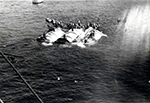 |
525k | View from the Sculpin (SS-191) of the Raising of the Pontoons Attached to the Bow of the Squalus (SS-192). | National Archives Identifier: 6281171 Photo courtesy of catalog.archives.gov | |
 |
213k | The Squalus (SS-192) and her pontoon make way to Portsmouth Navy Yard, Kittery, Maine on 12 August 1939. | USN photo # 326-39, courtesy of Scott Koen & ussnewyork.com. | |
 |
90k | View taken from Falcon (ASR-2) on 12 August 1939, after Squalus (SS-192) had been lifted off the sea bottom and was being towed to shallower water, supported by salvage pontoons. Wandank (AT-26) and a smaller tug (probably Penacook (YT-6) are towing, while Falcon acted as restraining ship. There are groups of three pontoons each visible on the surface at the submerged submarine's bow and stern. One more pontoon was underwater at the bow and three more at the stern. | Official USN photo # NH 57509, courtesy of the US Naval Historical Center. | |
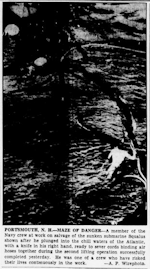 |
NR | PORTSMOUTH, N. H.—MAZE OF DANGER A member of the Navy crew at work on salvage of the sunken submarine Squalus (SS-192) shown after he plunged into the chill waters of the Atlantic, with a knife in his right hand, ready to sever cords binding air hoses together during the second lifting operation successfully completed yesterday. He was one of a crew who have risked their lives continuously in the work. |
Image and text provided by Library of Congress, Washington, DC. Photo & text by Evening Star. [volume] (Washington, D.C.) 1854-1972, 18 August 1939, Image 4, courtesy of chroniclingamerica.loc.gov. | |
 |
134k | The salvage pontoons proceed the sunken submarine to drydock. | USN photo courtesy of Scott Koen & ussnewyork.com. | |
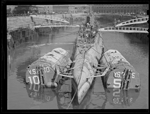 | 793k | Squalus (SS-192) safe in dry dock at Portsmouth Navy Yard, 15 September 1939. | Photo 08_06_023239 courtesy of the Boston Public Library, Leslie Jones Collection via Sean Hert & flickr.com. | |
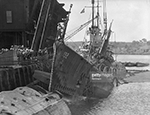 |
821k | (Original Caption) Portsmouth, N. H.: Squalus (SS-192) Back From The Deep. The U.S. Submarine Squalus, to salvage which 500 men of the U.S. Navy have labored for 113 days, is shown at her pier in Portsmouth Navy Yard today as water was pumped from her flooded compartments preparatory to the grim task of removing her 26 dead. Berthing of the submarine that sank off the Isle of Shoals last May 23 is the triumphant climax of one of the toughest salvage jobs ever tackled by the Navy. |
Photo Bettmann Collection/Getty Images, courtesy of gettyimages.com. | |
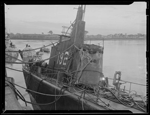 | 611k | Squalus (SS-192) damaged conning tower and pontoons, 15 September 1939. | Photo 08_06_023243 courtesy of the Boston Public Library, Leslie Jones Collection via Sean Hert & flickr.com. | |
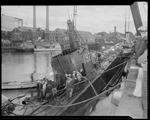 | 1.04k | Squalus (SS-192) crew and salvage workers pumping out last of the water in Portsmouth Navy Yard after the sub was rinsed. | Photo 08_06_023208 courtesy of the Boston Public Library, Leslie Jones Collection via Sean Hert & flickr.com. | |
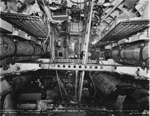 |
441k | Forward torpedo room of the Squalus (SS-192) after raising 15 September 1939. | USN photo # 448-39, courtesy of Scott Koen & ussnewyork.com. | |
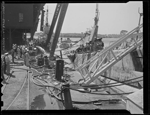 | 793k | After 113 days of salvage work, the sub Squalus (SS-192) is moored at Pier 6 at the Portsmouth Navy Yard on 15 September 1939. | Photo 08_06_023237 courtesy of the Boston Public Library, Leslie Jones Collection via Sean Hert & flickr.com. | |
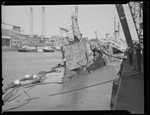 | 793k | Squalus (SS-192) at the Portsmouth Navy Yard. | Photo 08_06_023238 courtesy of the Boston Public Library, Leslie Jones Collection via Sean Hert & flickr.com. | |
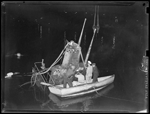 | 620k | Untangling the ropes around the conning tower of the Squalus (SS-192) at Portsmouth Navy Yard, 15 September 1939. | Photo 08_06_023250 courtesy of the Boston Public Library, Leslie Jones Collection via Sean Hert & flickr.com. | |
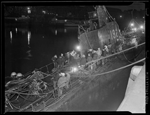 | 629k | Night falls on the Squalus (SS-192) at Portsmouth Navy Yard, 15 September 1939. | Photo 08_06_023241 courtesy of the Boston Public Library, Leslie Jones Collection via Sean Hert & flickr.com. | |
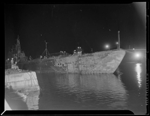 | 464k | Squalus (SS-192) completely afloat at Portsmouth Navy Yard, 15 September 1939. | Photo 08_06_023244 courtesy of the Boston Public Library, Leslie Jones Collection via Sean Hert & flickr.com. | |
 |
663k | Squalus (SS-192) floats on even keel at Portsmouth Navy Yard after removal of bodies, 15 September 1939. Note the position of the bow planes and the condition of the fairwater. The damage caused by the salvage chains and pontoons is evident but hard to make out clearly. You can see how the bridge was crushed. | Photo 08_06_023236 courtesy of the Boston Public Library, Leslie Jones Collection via Sean Hert & flickr.com. Photo i.d. courtesy of John Hart, Ric Hedman & David Johnston | |
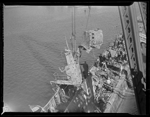 | 793k | Squalus (SS-192) conning tower dismantled at Portsmouth Navy Yard to get at bodies of the crew, 15 September 1939. | Photo 08_06_023244 courtesy of the Boston Public Library, Leslie Jones Collection via Sean Hert & flickr.com. | |
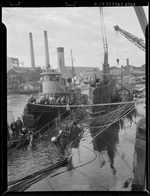 | 745k | Squalus (SS-192) tilted at awkward angle at Portsmouth Navy Yard, 15 September 1939. | Photo 08_06_023246 courtesy of the Boston Public Library, Leslie Jones Collection via Sean Hert & flickr.com. | |
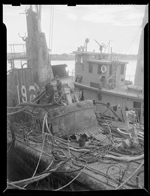 | 718k | Squalus (SS-192) tilted at awkward angle at Portsmouth Navy Yard, 15 September 1939. | Photo 08_06_023247 courtesy of the Boston Public Library, Leslie Jones Collection via Sean Hert & flickr.com. | |
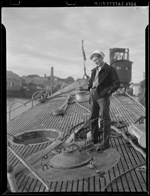 | 475k | Lost in thought on deck of the Squalus (SS-192) at Portsmouth Navy Yard, 15 September 1939. | Photo 08_06_023242 courtesy of the Boston Public Library, Leslie Jones Collection via Sean Hert & flickr.com. | |
 |
450k | Salvaging of the Squalus (SS-192) in dry-dock showing the general condition of the boat. Notice that at this point in her life there were NO limber holes in the superstructure aft of the bow planes. Therefore, any photos of the boat without limber holes present had to have been taken prior to her sinking on 23 May 1939. |
Text i.d. courtesy of David Johnston USN photo courtesy of Scott Koen & ussnewyork.com. |
|
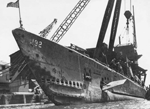 |
223k | Salvaging of the Squalus (SS-192) at dockside. | USN photo courtesy of Scott Koen & ussnewyork.com. | |
 |
21k | Commemorative post mark on the occasion of the
submarines Sargo (SS-188), Saury (SS-189), Spearfish (SS-190), Sculpin (SS-191), Squalus (SS-192) & Swordfish (SS-193) honoring Navy Day, 27 October 1939. |
Courtesy of Jack Treutle (of blessed memory). | |
 |
32k | Commemorative postal cover on the occasion of the de-commissioning of the Squalus (SS-192), 15 November 1939. | Courtesy of Jack Treutle (of blessed memory). | |
 |
24k | Commemorative postal cover on the occasion of the de-commissioning of the Squalus (SS-192), 15 November 1939. | Courtesy of Jack Treutle (of blessed memory). | |
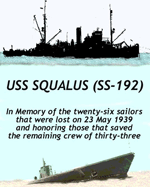 |
88k | Commemorative photo in honor of the memory of the crew of the Squalus (SS-192). | Photo courtesy of Tom Kermen. Dante's Prayer courtesy of Loreena McKennitt via loreenamckennitt.com | |
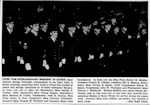 |
NR | CITED "FOR EXTRAORDINARY HEROISM" IN ACTION —Rear Admiral George Pettengill, commandant of the Navy Yard, is shown yesterday presenting Navy Cross to divers who worked at rescue and salvage operations on ill-fated submarine Squalus (SS-192). In front row, left to right, are Boatswain's Mate George F. Crocker, Chief Machinist's Mate George Bugner, Boatswain's Mate Edmund B. Crosby, Torpedoman Jesse E. Duncan, Ship Fitter Henry H. Frye, Carpenter's Mate Prentice Crittenden, Gunner's Mate Thomas, W. Forrester and Gunner's Mate Louis Zampiglione. In back row are Ship Fitter Robert M. Metzler, Coxswain Francis H. O'Keefe, Coxswain Neil O. Shahan, Boatswain's Mate Forrest E. Smith, Chief Torpedoman Walter H. Squire, Torpedoman John W. Thompson and Pharmacist's Mate Francis L. Westbrook. William Badders and James Harper McDonald, next in line, were two of four men who received Congressional Medals of Honor Friday for service during the rescue work. Gunner's Mate John Gilbert, not shown, also received a Navy Cross. |
Star Staff Photo Image and text provided by Library of Congress, Washington, DC. Photo & text by Evening Star. [volume] (Washington, D.C.) 1854-1972, 21 January 1940, Image 12, courtesy of chroniclingamerica.loc.gov. | |
 0816257s | NR | Master Diver in Navy Has Official Trophies of Thrilling Undersea Life Hero of Squalus (SS-192) Rescues, Has Medal of Honor, And Naval Cross Submarine Disasters Gave Field for Washingtonian To Achieve Record A life of adventure underneath the sea has been the role of William Badders, 38-year-old master diver of the United States Navy, ever since that day back in November, 1925. when he volunteered as a diver in the submarine S-51 (SS-162) disaster. The S-51 plunged to the bottom and stayed there, 132 feet below the surface of the Atlantic, off Block Island, after colliding with the steamer City oF Rome. There was a shortage of divers for rescue and salvage operations at the time, and Mr. Badders, member of the ship's company on the salvage boat Falcon (AM-28), offered himself as a pinch-hitter. Today, Mr. Badders, who lives at 1610 Ridge place S.E., can look back upon 15 years of deep-sea diving, service in the S-51, the S-4 (SS-109) and the Squalus submarine disasters, and to heroic duty that has brought him the Congressional Medal of Honor and the Naval Cross. He rescued 18 of the 33 men saved from the Squalus, and with another diver went down a third time in the diving bell to make sure there were no more survivors. |
Image and text provided by Library of Congress, Washington, DC. Photo from the Evening Star. [volume] (Washington, D.C.) 1854-1972, 17 March 1940, Image 37, via chroniclingamerica.loc.gov. | |
 |
344k | Sec. of the Navy Edison presents Medal of Honor for heroism to four men during rescue and salvage operations during Squalus's (SS-192) sinking on 23 May 1939. The ceremonies took place at the Navy department on 19 January 1940. Sec. of the Navy Edison also conducted a court of inquiry into her loss. |
USN photo courtesy of Scott Koen & ussnewyork.com. | |
| New Life |
||||
 |
12k | Istiophorus platypterus, a Sailfish. | Illustrated by Diane Rome Peebles. Photo courtesy of myfwc.com. | |
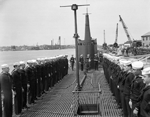 |
181k | The scene on the deck of the ill-fated U. S. Navy submarine Squalus (SS-192), 15 May 1940 as it was re commissioned under a new name---Sailfish, 15 May at the Portsmouth, N. H. Navy Yard today, 15 May. Lieutenant Commander John B. Longstaf, Aide to the Commandant at the Yard, read the orders of the Navy Department placing the submarine in commission and naming her Commander Lieut. Comm. Morton C. Mumma. The Squalus sank last 23 May off the Isles of Shoals, N. H., with a loss of 26 lives. Some of the survivors serve on the renamed sub. | Photo courtesy of the National Historical Center via Bill Gonyo. | |
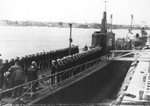 |
281k | The scene on the deck of the ill-fated U. S. Navy submarine Squalus (SS-192), 15 May 1940 as it was re commissioned under a new name---Sailfish, at the Portsmouth, N. H. Navy Yard. Notice that she now carries a single row of small circular limber holes in the superstructure aft of the bow planes. Any photo of the Sailfish that shows the row of small holes was taken sometime between her recommissioning on 15 May 1940 and a refit that she went through in September 1940. I believe that the post sea trials refit that she had that September to be the most logical time that the small holes were replaced with the large ones, obviously an effort to decrease dive times. |
Text i.d. courtesy of David Johnston USN photo courtesy of Scott Koen & ussnewyork.com. |
|
 |
120k | Commemorative postal cover on the occasion of the commissioning of the Sailfish (SS-192), 15 May 1940. | Courtesy of Tommy Trampp. | |
 |
70k | Commemorative postal cover on the occasion of the commissioning of the Sailfish (SS-192), 15 May 1940. | Courtesy of Jack Treutle (of blessed memory). | |
 |
163k | Re-introducing the Sailfish (SS-192), on the occasion of her re-commissioning on 15 May 1940. | Photo courtesy of Bill Gonyo. | |
 |
17k | One year commemorative postal cover dedicated to the memory of the crew of the Squalus (SS-192) who died at their posts when the boat sank by mechanical failure, 23 May 1939. | Courtesy of Jack Treutle (of blessed memory). | |
 |
36k | Commemorative postal cover on the occasion of the Sailfish's (SS-192) first submergence, 29 June 1940. | Courtesy of Jack Treutle (of blessed memory). | |
 | 46k | Commemorative post mark on the occasion of Navy Day, 27 October 1940, commemorating the participation of: Sailfish (SS-192), Seadragon (SS-194), Sealion (SS-195), Searaven (SS-196), Seawolf (SS-197), Tambor (SS-198), Tautog (SS-199), Thresher (SS-200), & Triton (SS-201). Note: YN1 Loyal Day was a plankowner of Sealion and aboard when she was bombed on 10 December 1941. | Courtesy of Ric Hedman. | |
 |
160k | Commemorative postal cover on the occasion of Sailfish (SS-192) shakedown cruise with Lt. Comdr. Morton C. Mumma commanding on 18 November 1940. | Photo courtesy of Bill Gonyo. | |
 |
455k | Pre-war photo of the Sailfish (SS-192) underway, probably taken during her post recommissioning sea trials sometime in the summer of 1940, definitely prior to the refit that ended in September. She still has the row of small holes. I believe this to be the Cape Cod Canal, Massachusetts. Any photo of the Sailfish in her original configuration with the large limber holes present would have to be dated after September 1940 and the start of the war. |
Photo courtesy of Arnold Putnam. Photo i.d. courtesy of David Johnston & Robert Morgan. |
|
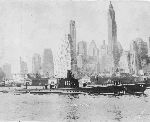 |
181k | Sailfish (SS-192) in New York City harbor, with the Porto Rico (that's how it is spelled in the photo) terminal buildings behind her, probably taken after her departure from Portsmouth, and during her transit south for Panama and the Pacific, most likely in January 1941. Probably a publicity stop of the famous boat and a chance for one last liberty call prior to leaving the east coast for good. She now carries a single row of large semi-circular limber holes. | Text i.d. courtesy of David Johnston USN photo contributed by Skip Riser. |
|
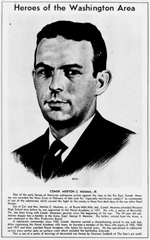 0819271 |
NR | COMDR. MORTON C. MUMMA, JR. One of the early heroes of American submarine action against the Japs in the Far East, Comdr Mumma was awarded the Navy Cross in February of last year for "especially meritorious conduct" as commander of one of the submarines which carried the fight to the enemy in those first dark days of the war after Pearl Harbor...... |
Image and text provided by Library of Congress, Washington, DC. Photo from the Evening Star. [volume] (Washington, D.C.) 1854-1972, 26 September 1943, Image 108, via chroniclingamerica.loc.gov. | |
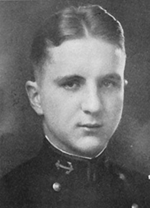 | 68k | Commander Richard George Voge served a four-month tour of duty as commissioning executive officer of Rowan (DD-405) from late September 1939 to late January 1940. In mid-February Comdr. Voge returned to the Asiatic Fleet and assumed command of Sealion (SS-195), based at Cavite in the Philippines, and commanded that submarine until the opening day of American participation in World War II. At the outbreak of hostilities on 8 December 1941 (West Longitude Time), Voge suffered the double ignominy of having his command caught in overhaul and, three days later, of losing her to enemy bombs while still at Cavite Navy Yard. Voge, however, quickly recovered from that blow, assumed command of Sailfish (SS-192) on 17 December 1941. | Photo courtesy of the Lucky Bag yearbook – Class of 1925 via Bill Gonyo. | |
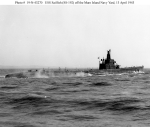 |
90k | Sailfish (SS-192) off the Mare Island Navy Yard, Vallejo, CA., 13 April 1943. | US National Archives photo # 19-N-43270, from the Bureau of Ships Collection. | |
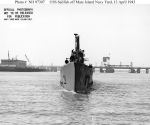 |
90k | Sailfish (SS-192) off the Mare Island Navy Yard, Vallejo, CA., 13 April 1943, following an overhaul. | USN photo # NH 97307, from the collections of the US Naval Archives. | |
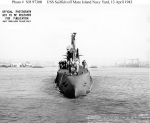 |
90k | Sailfish (SS-192) off the Mare Island Navy Yard, Vallejo, CA., 13 April 1943, following an overhaul. | USN photo # NH 97308, from the collections of the US Naval Archives. | |
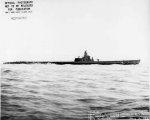 |
95k | Broadside view of the Sailfish (SS-192) off Mare Island on 13 April 1943. | USN photo # 2566-43, courtesy of Darryl L. Baker. | |
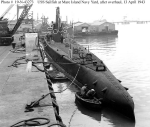 |
90k | Sailfish (SS-192) at the Mare Island Navy Yard, Vallejo, CA., 13 April 1943, following an overhaul. Circles on the photograph identify recent alterations to the ship. Note men in rowboat inspecting her limber holes, by the stubs of her removed propeller guards. Barges YF-200 and YF-190 are in the center background. | US National Archives photo # 19-N-43273, from the Bureau of Ships Collection. | |
 | 897k | After refit at Pearl Harbor, she departed on 17 November 1944 for her tenth patrol, which took her south of Honshu. Prior to arriving on station, after refueling at Midway, she intercepted a fast convoy of Japanese ships on the night of 3 December about 240 miles southeast of Yokosuka. The group consisted of a carrier, a cruiser, and two destroyers. Despite high seas whipped up by typhoon winds, shortly after midnight of the 4th, Sailfish (SS-192) maneuvered into firing position and fired a spread of three torpedoes at the carrier, scoring two hits. She went deep to escape the escorting destroyers, but resurfaced within a few hours to resume the attack. Before dawn, she fired another spread of three "fish," scoring two more hits on the stricken carrier. Eluding the Japanese ASW attack, which was hampered by the raging seas, Sailfish came to periscope depth at dawn and saw the carrier dead in the water, with a list to port and down by the stern. Preparations to abandon ship were in progress. Later in the morning, Sailfish fired another spread of three torpedoes, scoring two final hits. Loud internal explosions and breaking-up noises were heard, while the submarine went to test depth to escape a depth charge attack. Shortly afterwards, the carrier, Chuyo, went to the bottom. | Text courtesy of DANFS. Photo courtesy of wikimedia.org. PDF courtesy of Scott Koen & ussnewyork.com. |
|
 |
16k | Sailfish (SS-192), oil painting, unknown artist, circa 1943/45. | Author's collection. | |
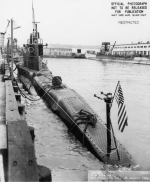 |
192k | Aft plan view of the S-43 (SS-154) at Bethlehem Shipbuilding in San Francisco on 26 January 1944. The scaffolding belongs to the Sailfish (SS-192) to the right; Shad (SS-235) is forward of S-43 (SS-154), and unknown covered barge is berthed between Shad and Sailfish. | USN photo # 642-44 courtesy of Darryl L. Baker. Photo i.d. courtesy of David Johnston |
|
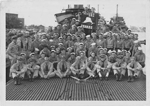 |
295k | Sailfish (SS-192) after a war patrol. Capt. Ward is in center and my dad LCDR Killraine Newton, USN, is 2nd to right of the flag. The man next to the flag is Bud Pike. | USN photo courtesy of Dwayne Newton. | |
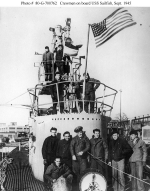 |
90k | Sailfish (SS-192) crew members pose by the after end of the conning tower, while Sailfish was at Naval Submarine Base, New London, Groton, CT., in 1945. Her Presidential Unit Citation flag is behind the periscope shears, in upper center. Original photo is dated September 1945. "The man kneeling on the left is Ray Bunt holding shell of a sea turtle he caught and the crew ate. Other crew shown are Joe McGrievy, in the Navy chief's hat, (left to right) Gail Lusk, Bob Kempf, and Troy Ray. The man standing on the smoking deck to the left of the flag staff is "William J. Dillon (known as "Skippy" on the Sailfish since I was the radioman,radarman, sonarman on board)" and provided the above identifications. |
US National Archives photo # 80-G-700762. Thanks to William J. "Skippy" Dillon via Ric Hedman for supplying the names of his shipmates in this photo. | |
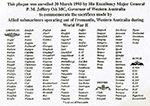 |
365k | This plaque was unveiled 20 March 1995 by His Excellency Major General P.M. Jeffery OA MC, Governor of Western Australia to commemorate the sacrifices made by Allied submarines that operated out of Fremantle, Western Australia during WW II. | Photo courtesy of Ron Reeves (of blessed memory). | |
 |
230k | Crowds line the shore 27 October 1945 at Portsmouth Naval Shipyard. The Sailfish (SS-192) was making one last pierside dive prior to decommissioning. | USN photo # 326-39, courtesy of Scott Koen & ussnewyork.com. Photo i.d. courtesy of David Johnston | |
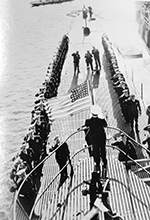 |
559k | Navy Day, 27 October 1945. Lowering the flag on the deck of Sailfish (SS-192) during Navy Day decommissioning ceremony at Portsmouth, New Hampshire, marks the final chapter in the life of the famous submarine. | Photo Lot-10625-12. Donated by Mr. Thomas J. Watson from a recording America's tribute to its victorious fleet in first peacetime Navy Day since the start of World War Two, from the National Museum of the U.S. Navy, courtesy of flickr.com. | |
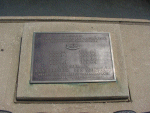 | 91k | Memorial plaque at Independence Seaport Museum, Philadelphia PA, July 2006 for the crews of United States submarines lost during peace time accidents: F-1 (SS-20), F-4 (SS-23), G-2 (SS-27), H-1 (SS-28), O-5 (SS-66), O-9 (SS-70), S-4 (SS-109), S-51 (SS-162), Squalus (SS-192), Scorpion (SSN-589) & Thresher (SSN-593). | Photo courtesy of Wendell Royce McLaughlin Jr. | |
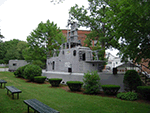 |
1.00k | The sail of the Sailfish (SS-192) preserved as a memorial to its crew, at the US Navy's Portsmouth Naval Shipyard, Kittery, Maine. | Photo courtesy of Charles A. Thompson. | |
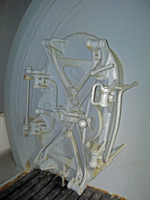 |
892k | This 2010 photo shows the gun access hatch in the after CT bulkhead, located inside the dog house of the Sailfish (SS-192). | Photo i.d. courtesy of John Hummel, USN (Retired). Photo courtesy of Charles A. Thompson. | |
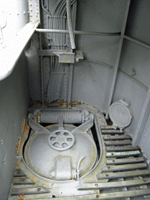 |
697k | This photo shows the hatch leading down to the conning tower from the bridge. | Photo courtesy of Charles A. Thompson. | |
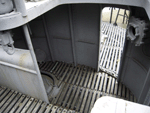 |
656k | This is looking down and forward from the bridge. On the lower left the hatch to the conning tower below is visible, and on the right is the open door to the forward gun deck. | Photo courtesy of Charles A. Thompson. | |
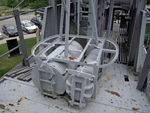 |
1.00k | The after cigarette desk sloping down, with a couple of ready service lockers below the raised aft TDC platform. | Photo courtesy of Charles A. Thompson. | |
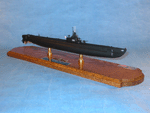 | 764k | Four photo PDF of the Sailfish (SS-192). | Photos courtesy of Mel Douyette @ coldwarsubmarines.com | |
 |
698k | The Honorable Richard Danzig (right) Secretary of the Navy meets with Mr. Donato "Dan" Persico and Mr. Carl Bryson (center), 19 September 2000. Both men are survivors of Squalus (SS-192), a USN submarine that sunk in 240 feet of water off the Isle of Shoals in May 1939. | National Archives Identifier: 6610885 Local Identifier: 330-CFD-DN-SD-03-11757 Photo courtesy of catalog.archives.gov | |
View the Squalus / Sailfish (SS-192)
DANFS history entry located on the Haze Gray & Underway Web Site.
Crew Contact And Reunion Information
U.S. Navy Memorial Foundation
Fleet Reserve Association
Additional Resources and Web Sites of Interest
On Eternal Patrol
ComSubForPac USS SQUALUS (SS-192) 23 May 1939 - 26 Men Lost
They Brought Them Up Alive By Admiral Charles A. Lockwood & H.C. Adamson
PigBoats.COM TM - A Historic Look at Submarines
Ep-21 (1) - Victory At Sea ~ Full Fathom Five - HQ
| Back To The Main Photo Index | Back To the Submarine Index |
|
Problems and site related matters, E-mail Webmaster |
|
This page is created by Gary Priolo and maintained by Michael Mohl All Pages © 1996 - 2024 NavSource History |